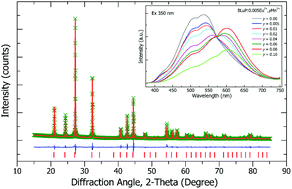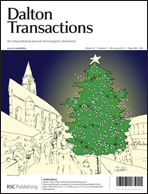A novel orange-yellow-emitting Ba3Lu(PO4)3:Eu2+,Mn2+ phosphor with energy transfer for UV-excited white LEDs†
Abstract
Eu2+–Mn2+ codoped orange-yellow-emitting Ba3Lu(PO4)3 phosphors were synthesized by a solid-state reaction. The synthesis, structure refinement, and luminescence properties of the obtained phosphor were first investigated in detail. The crystal structure was refined with a split-atom model, where the oxygen atoms are distributed over two partially occupied sites. The refinement confirmed that BLuP:0.005Eu2+,0.06Mn2+ has a cubic unit cell with space group I![[4 with combining macron]](https://www.rsc.org/images/entities/char_0034_0304.gif) 3d (no. 220), cell parameters a = b = c = 10.4025 Å and Z = 4. The luminescent properties reveal that the developed phosphor can efficiently convert UV
3d (no. 220), cell parameters a = b = c = 10.4025 Å and Z = 4. The luminescent properties reveal that the developed phosphor can efficiently convert UV


 Please wait while we load your content...
Please wait while we load your content...